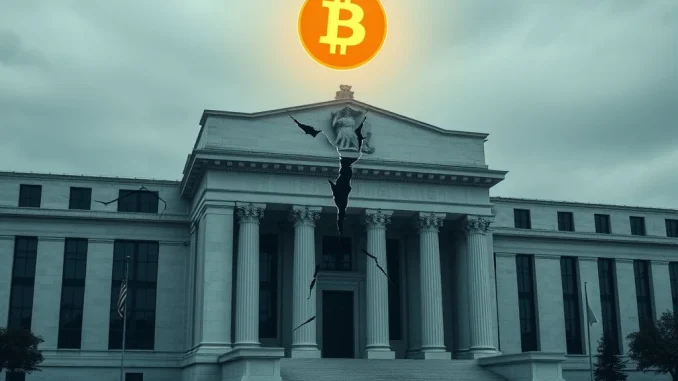
The financial world is abuzz, and the spotlight is firmly on the U.S. Federal Reserve. Recent reports reveal an astonishing operational loss exceeding $100 billion, a figure that has sent ripples across markets and ignited a fierce debate about the stability of traditional monetary systems. This unprecedented strain on the Fed’s balance sheet, primarily driven by elevated interest rates outpacing its income, is compelling institutional investors and everyday individuals alike to reconsider their financial strategies. Could this be the moment for accelerated Bitcoin adoption?
Understanding the Fed Losses: A Strain on Traditional Finance
The U.S. Federal Reserve, the cornerstone of the world’s largest economy, has disclosed operational losses surpassing $100 billion. This significant financial hit isn’t a simple accounting anomaly; it’s a direct consequence of sustained high-interest rate environments. The Fed’s income, primarily derived from reserve balances and reverse repo agreements, has been outpaced by the higher interest it pays on those very reserves. Treasury Secretary Scott Bessent didn’t mince words, calling for a comprehensive review of the Fed’s practices, likening the situation to a critical failure in another vital sector: “If this were the Federal Aviation Administration and we were having this many mistakes, we would go back and look at why has this happened.”
This financial strain is compounded by prolonged rate hikes and quantitative tightening measures, designed to curb inflation. However, critics argue these measures have fallen short of their primary goal, instead exacerbating market volatility and fueling skepticism about the efficacy of conventional central banking tools. The implications are profound: a weakening trust in centralized financial institutions and a growing search for alternatives.
Key takeaways from the Fed’s financial situation:
- Operational Losses: Over $100 billion, primarily due to higher interest payments on reserves.
- Policy Challenges: High interest rates and quantitative tightening aimed at inflation control have had unintended side effects.
- Erosion of Trust: Growing skepticism about the effectiveness and stability of traditional monetary systems.
Bitcoin Adoption: Is It the Ultimate Hedge Against Financial Instability?
Against the backdrop of the Fed’s struggles, Bitcoin has emerged as a compelling narrative, gaining significant traction as a potential hedge against currency devaluation and systemic risks. Proponents of Bitcoin adoption highlight its inherent characteristics: a fixed supply of 21 million coins and a decentralized structure. These features, they argue, offer a robust safeguard against the kind of centralized monetary manipulation and policy missteps that traditional systems are prone to. The narrative is simple yet powerful: if central banks struggle, a decentralized, immutable asset becomes more attractive.
Institutional inflows into the cryptocurrency market have notably surged, particularly through futures-based ETFs. This indicates a growing comfort among sophisticated investors with integrating digital assets into their portfolios, even as Bitcoin’s price has seen recent fluctuations, retreating below $116,000 after attempts to breach key resistance levels. This institutional interest is a crucial validation point, suggesting that Bitcoin is moving beyond speculative retail trading to become a recognized asset class.
Navigating Cryptocurrency Investment: Challenges and Opportunities
While the allure of Bitcoin as a hedge is strong, engaging in cryptocurrency investment comes with its own set of challenges. Critics are quick to point out Bitcoin’s historical volatility, questioning its viability as a long-term store of value. Indeed, significant price swings remain a characteristic of the crypto market, demanding a higher risk tolerance from investors.
However, financial experts increasingly suggest that Bitcoin’s role in diversifying portfolios is set to grow. This is particularly true as regulatory scrutiny on crypto markets shows signs of easing, and traditional financial systems face increasing scrutiny. The ongoing dialogue between regulators and the crypto industry is slowly paving the way for clearer guidelines, which could reduce uncertainty and attract even more mainstream capital.
Considerations for Cryptocurrency Investment:
- Volatility: High price fluctuations require a long-term perspective and risk management.
- Decentralization Benefits: Protection against central bank policies and currency debasement.
- Regulatory Landscape: Easing regulations could foster greater institutional participation.
- Diversification: Bitcoin offers a unique, uncorrelated asset for portfolio diversification.
Are Fiat Alternatives Becoming Essential in a Shifting Landscape?
The current financial climate, marked by persistent inflationary pressures and the Fed’s operational losses, intensifies the discussion around the need for fiat alternatives. Historically, periods of significant financial instability have correlated with heightened interest in Bitcoin. The current $100 billion loss, while not tied to a single catastrophic event, aligns with patterns observed during past crises, such as the 2008 financial collapse, where trust in conventional systems waned.
A Brookings policy analysis underscores this trend, noting that “oversight is weakening, enforcement is being scaled back, and the crypto industry is gaining political and regulatory ground—heightening both risks and opportunities for crypto markets in a less stable fiat environment.” This dynamic suggests a future where digital assets could play an increasingly vital role as a counterbalance to traditional currencies. For investors, this means actively exploring assets that are not directly controlled or influenced by central banks and government policies, offering a true hedge against inflation and devaluation.
The Central Bank Crisis and the Future of Global Finance
The challenges faced by the Federal Reserve are not isolated incidents but symptoms of a broader discussion about the limitations of centralized financial systems. This ongoing central bank crisis of confidence, whether explicit or implicit, is reshaping investment strategies globally. While Bitcoin’s widespread adoption remains constrained by factors like scalability and regulatory uncertainties, the recent surge in institutional inflows is a clear indicator of growing confidence among sophisticated players.
The interplay between traditional monetary policy failures and the rise of decentralized alternatives like Bitcoin highlights a profound shift in global finance. Technological innovation, coupled with policy uncertainty, is redefining what constitutes a stable and valuable asset. As central banks worldwide navigate complex economic landscapes and make their next policy decisions, the debate over Bitcoin’s role in a ‘post-trust’ economy is not just poised to remain central but likely to intensify, influencing investment decisions for years to come.
The narrative is clear: traditional finance is facing unprecedented challenges, and the search for resilient alternatives is more urgent than ever. Bitcoin, despite its volatility, is increasingly seen not just as a speculative asset but as a foundational element of a diversified portfolio, offering a decentralized counterpoint to the complexities of conventional monetary policy. The $100 billion question isn’t just about the Fed’s losses; it’s about the future of money itself.
Frequently Asked Questions (FAQs)
Q1: What caused the U.S. Federal Reserve’s $100 billion loss?
The Federal Reserve’s operational losses, exceeding $100 billion, are primarily due to elevated interest rates. The interest it pays on reserve balances and reverse repo agreements has outpaced its income from these operations, leading to a significant deficit.
Q2: How does the Fed’s loss relate to Bitcoin adoption?
The Fed’s financial strain and the perceived challenges of traditional monetary systems have sparked renewed interest in Bitcoin. Proponents argue Bitcoin’s fixed supply and decentralized nature offer a safeguard against centralized manipulation and currency devaluation, making it an attractive alternative for investors seeking stability.
Q3: Is Bitcoin a safe investment during financial instability?
Bitcoin’s role as a safe haven is debated. While its decentralization and limited supply appeal to investors during periods of fiat currency uncertainty, its high volatility remains a significant risk. Financial experts suggest it can be a valuable diversification tool, but it’s crucial to understand its risk profile.
Q4: What are institutional investors doing in response to these financial shifts?
Institutional investors are increasingly exploring cryptocurrency investment, particularly through vehicles like futures-based ETFs. This indicates a growing comfort with digital assets as part of a diversified portfolio, even amid market fluctuations. They are reevaluating traditional assets in light of central bank challenges.
Q5: What are the main arguments for and against Bitcoin as a long-term store of value?
For: Fixed supply, decentralization (no single point of failure or manipulation), potential hedge against inflation and currency debasement. Against: High price volatility, regulatory uncertainties, scalability concerns, and its relatively short history compared to traditional assets.
Q6: How might the easing of regulatory scrutiny impact Bitcoin’s future?
An easing of regulatory scrutiny could significantly boost Bitcoin’s mainstream adoption and appeal. Clearer regulations might reduce uncertainty for institutional investors, attract more capital, and facilitate broader integration of cryptocurrencies into the global financial system, potentially stabilizing its price and increasing its utility.



